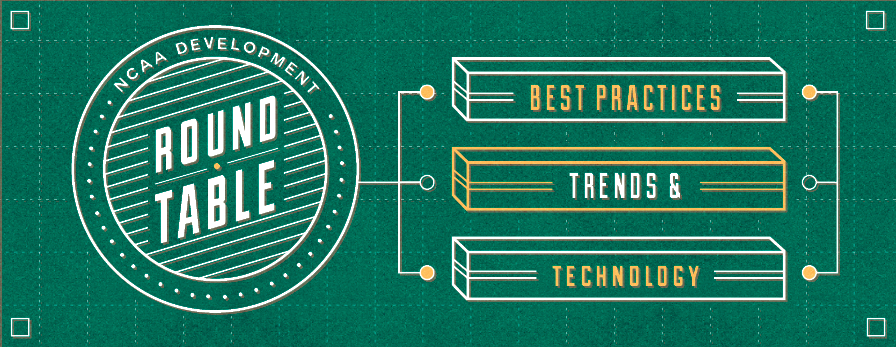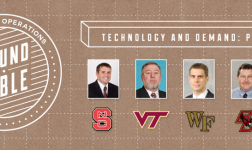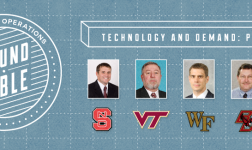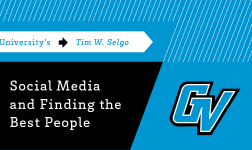Fund-raising has become possibly the most pivotal and time-consuming duty for athletic directors today. On top of their traditional administrative responsibilities, athletic directors are now counted upon to market the university tirelessly, attracting big-time donors along the way. Athletic department fund-raisers provide crucial support to the athletic director in this process, helping to cultivate donors and persuading them to open their checkbooks to finance projects that will keep the university on the cutting edge in athletics.
In this Development Round Table, four successful fund-raisers give their thoughts about best practices, trends, and technology in the world of college athletics development. We are grateful to Mike Piscetelli, Matt Borman, John Montgomery, and Stephen Ponder for sharing their perspectives in this round table.
1. Discuss one innovative initiative you have recently implemented.
MIKE PISCETELLI– We have begun to utilize video conferencing software (WebEx) to conduct annual sport-specific alumni conference calls to kick off the season for each of our teams. The calls/webcasts are led by the head coach, who gives a rundown of the returning roster, freshman roster, schedule, recruiting, alumni events (reunion weekends), and also discusses our capital projects, incorporating visuals and/or video for those on the call to follow. The call allows a touch point to a mass amount of former student-athletes, a segment of donors that has a strong affinity for sport-specific projects, and it also qualifies those who make the call as potential follow-ups for the development office to further the conversation about the needs/priorities of the program. We will be looking to incorporate a call/webcast similar to this for donors who have commitments or are interested in committing to a project for one of our programs.
JOHN MONTGOMERY – While changing a stadium seating policy is not in itself innovative, the Equity Seating Plan instituted for Kenan Stadium last spring unveiled a model for true fairness among all Rams Club members with season tickets. The Equity Seating Plan allows all members with tickets to choose their seat location based upon their membership rank. While annual giving levels determine the number of tickets you can select on priority, a member’s lifetime of participation (reflected in their priority points, and thusly, their rank) determines seat selection order.
This approach does not place emphasis on quick-fix annual gifts or one-time, point-building gifts to be used toward a single selection process, but rather encourages donors to look at a lifetime of giving and the associated seat improvement that may be realized over time. The long-term health of The Rams Club and, subsequently, Carolina Athletics should benefit from this tactic.
STEPHEN PONDER – In an effort to finish our $32.4 million Legacy Campaign for football and basketball practice facilities, we developed a program called “Devil Docs” that targeted doctors and anyone involved in the medical industry to sign multiyear pledges to name our sports medicine facility under the banner of “Devil Docs” with each member’s name on the plaque. Our initial goal of 25 was met quickly, and we are now targeting 100 pledges and $1 million overall from this program.
MATT BORMAN – We’re taking advantage of our exciting Orange Bowl win to stimulate a grassroots fund-raising campaign. To honor our football team’s outstanding performance of scoring 70 points in the Orange Bowl, we’re offering a limited-time introductory membership for $70, whereas our normal introductory level is $100. Donors who sign up during this promotional campaign receive all the benefits of a typical membership in the Mountaineer Athletic Club (MAC), and also get to attend a football recruit signing-day party. The campaign has resulted in increased membership and lots of excitement.
2. Describe one critical characteristic of a successful NCAA fund-raiser.
MIKE PISCETELLI – To be a good listener is a trait a calling officer must develop to perfection. All too often a fund-raiser is so focused on the hard figure objective that they never hear the donor’s true passion for the program. Listening intently and asking pertinent questions based on what one hears will encourage the donor to express their passion, and that is often when you can hone in on the specifics of the gift. In most cases, you have to hit the heart of the donor, and the donor will talk themselves into a gift for you … if you let them.
JOHN MONTGOMERY – The ability to inspire and engender trust is a characteristic that is critical to the fund-raising process. To gain the trust of donors, the fund-raiser must use skills such as listening, relationship building, and the proper communication of the organization’s priorities. When trust is gained, the overall relationship between the donor and the organization will develop into one that is truly beneficial for both parties.
STEPHEN PONDER – I believe they must have a presence that attracts other people to want to be around them.
MATT BORMAN – To be a great fund-raiser, you have to be a great listener. As a fund-raiser, you’re always very eager to get in front of a prospect and educate them on the needs of your institution, and make that ask based on what you and your staff feel is important. It’s critical to be able to mold your solicitations to their interests and make sure the donors know you care about them personally. In order to build strong, long-term relationships with donors, you have to intently listen and understand their needs.
3. Can you cite a few specific examples of how technology has impacted development in recent years?
MIKE PISCETELLI – Technology has vastly improved a number of areas of development, but one area of fund-raising that has benefited tremendously is the access to prospect information and the ability to track a donor. Functions like Google alerts or watch lists, such as Forbes CEO Tracker, bring information to you on a daily basis without having to repeatedly search for the information weekly, monthly, or yearly. There is great value in knowing when a donor or prospect gets promoted, takes a new job, or signs a new professional contract. Taking that knowledge and turning it into a cultivation or stewardship act is the biggest sticking point. With information being filtered to smartphones, it reaches you instantly, allowing you to act in a timely manner.
JOHN MONTGOMERY – We seek to embrace technology as best we can. A few examples:
The Rams Club began offering online log-ins to members in 2003. The log-in feature allows members to make gifts, manage their account, change contact information, etc. In FY2011, just eight years since first offering this feature to members, The Rams Club collected more than $4.46 million in gifts from more than 6,000 transactions.
The Rams Club utilized software from a leading sports marketing technology firm in 2011 (and will do so again in 2012) to allow donors to choose their own seating in Kenan Stadium as part of the reseating process. By placing the decision on seat location directly in the hands of the donor, The Rams Club gave “ownership” of the process and the seats to the donor—a significant factor in helping sell the new system to a concerned donor base.
Social media have allowed The Rams Club to reach donors and prospects quickly and inexpensively. With nearly 4,700 followers on Facebook and 2,600 followers on Twitter, The Rams Club can disseminate information in an efficient manner.
STEPHEN PONDER – I have seen development officers sign up for Twitter and ask their donors to “follow” them to keep up-to-date on events, information, and other tidbits that all of our donors want to know.
I have seen examples of donor stories on Facebook, especially highlighting kids clubs. Once you get their kids involved, you have the parents and their grandparents for sure.
Renewals for tickets and donations have become much more solely focused through online platforms versus receiving a renewal form in the mail.
MATT BORMAN – One area that comes to mind is reseating or select-a-seat programs. When people started reseating a few years ago, it was necessary for every donor to schedule an appointment to come in and personally select a seat. Now there are services that allow you to bring your arena to the donor over the Internet. It makes seat selection easier, faster, and more convenient while creating a better fan experience for the donors. Also, utilizing social media platforms such as Twitter and Facebook allows us to get much more information out to the masses more effectively now than ever before.
4. Discuss how economic conditions have altered/impacted your fund-raising strategy in the last 2-3 years.
MIKE PISCETELLI – While the last few years have not been kind to everyone, they have proven to be a “payday” for some donors. What needs to be understood during uncertain economic times is that patience is key. Use this time to show a donor you are there for them even when their ability isn’t what it may have been, or what they were hoping for it to be at a particular stage in their giving life. The best part of development is that every donor’s situation is different, and you can have some in your portfolio that thrive during a poor economy. The remedy is to ramp up your visits and don’t forget the donors who have historically been there to support the program.
JOHN MONTGOMERY – Economic conditions have caused our organization to examine the way we approach planning. We have always set ambitious goals and will continue to do so, but our goals and strategies are more thoroughly analyzed and vetted by our staff, the athletic director, and the Foundation’s Executive Board. The goals/priorities must be aligned with our primary mission—providing scholarship support for our student-athletes—and our fund-raisers are urged to more effectively communicate the mission as they seek funding for these priorities. Also, this process has engaged our board at a higher level and has had a positive impact on strategic planning and fund-raising results.
STEPHEN PONDER – The Arizona market was one of the hardest hit areas in the United States in 2008-2009. Real estate and everything associated with it drove our economy during the boom. Once that dried up, we were faced with unprecedented losses in terms of donors and dollars. We focused on personal visits with as many people as possible during this time. We felt that it was harder for our donors to walk away if they had a deeper relationship with us.
MATT BORMAN – We’re fortunate that we have a tremendously loyal and passionate donor base. As the flagship university in the state of West Virginia, we’re essentially the professional sports team in our state. We’ve continued to grow every year even as the economy has weakened in recent years. One effect we’re seeing is more reluctance by donors to sign multiyear commitments. That means that our development staff has had to be more diligent and methodical in our yearly follow-ups to ensure a high level of success for the MAC and WVU Athletics.
5. What’s the next big trend you see in development?
MIKE PISCETELLI – As online giving and use of smartphones to make donations and/or purchases increases, I would have to imagine development operations will look to incorporate e-transaction type methods into the lives of their donors. As many of us have seen, grocery stores and convenience stores have loyalty cards that get scanned when purchases are made to track a customer’s behaviors, which in turn promotes more shopping by that customer due to follow-up e-mails and offers about items related to what they have been buying. If a development office could get information as it relates to spending on a program, it would be useful information. To know which patrons buy merchandise, bid for online auction items, eat food on game day, or make transactions online can help to paint a better picture of a donor. More importantly it can shed light on how to reinforce the behaviors of the donor to execute these digital transactions so that gifting is made as easy as possible. I believe the more we can incorporate these different types of transactions with an athletics department brand, the more apt a donor would be to making gifts when prompted.
JOHN MONTGOMERY – The commitment to continue to be innovative and communicate to our donor base through the use of technology is setting the stage for the next big trend—a basic fundamental—relationship building and donor service. As our donor base becomes more tech savvy, and demands more information and access, it is important that we provide those things while maintaining and growing donor relationships through personal contact. Technology will help us engage the next generation of donors, but we must not discount the importance of visiting with our donors, developing relationships, and discussing priorities and opportunities to give.
STEPHEN PONDER – How we effectively communicate with our donors carrying the same consistent message through many different forms of media. The integration of Twitter, Facebook, Websites, online newsletters, texting, and videos will be our challenge. Our donors want more information but in shorter stories or formats. The “ticker” syndrome at the bottom of the TV screen has really spilled over to our donors’ attention spans in terms of wanting more information with less detail. We have to be creative on how we can continue to educate and get to the hearts of our donors.
MATT BORMAN – I think you’ll see more and more schools refocus their premium seating strategies. I anticipate you’ll see less of a focus on big, 20- to 30-seat suites and a renewed focus on providing flexible premium seat options for individuals. The ability to micro-target donors and offer exciting suite packages creates a better fan experience and supports the goals of our fund-raising team. I also think more and more programs are trying to get donors to do more online—including giving and renewals. However, I don’t think those online tools will ever replace the need to get out, pound the pavement, and get to know the people who support your program.
 Mike Piscetelli
Mike Piscetelli
Assistant Athletic Director, Major Gifts
Wake Forest University
 John Montgomery
John Montgomery
Executive Director of The Rams Club
University of North Carolina at Chapel Hill
 Stephen Ponder
Stephen Ponder
Senior Associate Athletic Director, Development
Arizona State University
 Matt Borman
Matt Borman
Executive Director, Mountaineer Athletic Club
West Virginia University
Key Insights
Modern-day strategies such as the use of social media and online seat selection are valuable tools for the college athletics fund-raiser, but it remains critical to “pound the pavement” and develop personal relationships with current and potential donors.




